Franchising, retail, business
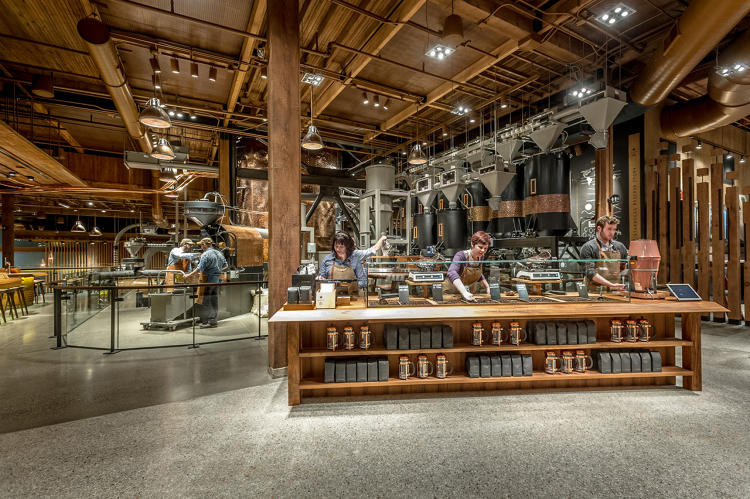
05/12/2014
STARBUCKS HAS OPENED A NEW FLAGSHIP CAFE WHERE THEY ALSO ROAST THEIR GLOBAL SUPPLY OF SMALL BATCH COFFEES.
I’m standing in a 15,000-square-foot factory that could only be the work of Starbucks. Hulking industrial equipment stands alongside custom walnut furniture that's finished so delicately I'm afraid to place my coffee cup on it without a coaster.
Sunlight pours through a three-story-tall copper silo, as beans whir in pipes overhead, trickling like the sound of rain into elegant glass vats.
It’s monstrous. It’s gorgeous. It’s LEED-certified.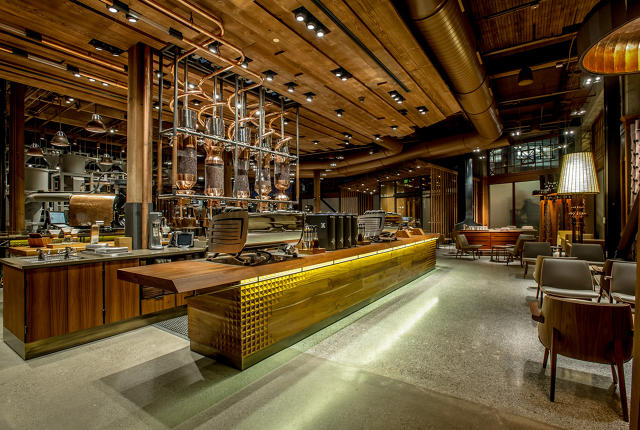
In the sort of tasteful spectacle you'd come to expect from a brand monolith like Starbucks, two coffee bars, a shop, a standalone restaurant, a two-story library with 200 books, and a factory all fit under one roof in a caffeinated wonderland sitting at the top of Seattle’s swank Capitol Hill district. This giant new flagship store is the largest Starbucks ever built. It’s also a production plant where the company will roast its "small batch" Reserve line for the entire world. That's a projected 1.4 million pounds of coffee to be roasted and packaged a year, all while the public is free to watch, sip coffee brewed by the most eager and informed Starbucks baristas I've ever met, and interrupt the guy manning the roaster to ask him a question. It's as much a meticulously groomed peek inside Starbucks's global roasting and distribution system as it is an advertisement for Starbucks itself.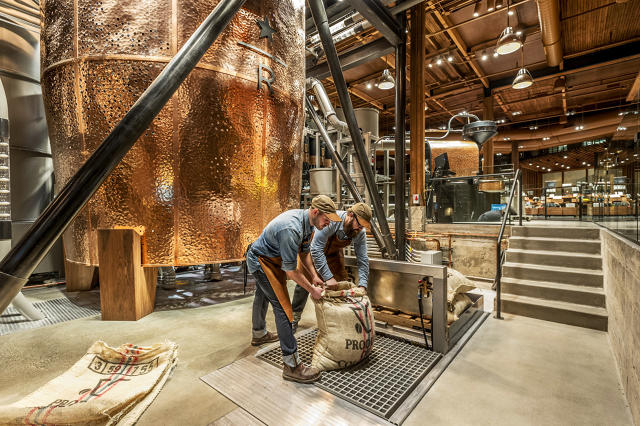
THE WILLY WONKA OF COFFEE
"It’s a little bit like Willy Wonka," says designer Liz Muller. It’s three days before opening and she walks me through the store while baristas, construction workers, roasters, and promoters bustle about, testing new pour-over spigots and inspecting read-outs from roasting equipment. Muller is the 52-year-old Dutch designer behind Starbucks’s most experimental stores, from a cafe placed inside an Amsterdam bank vault with a ceiling of 1,876 hand-carved blocks of wood, to coffee shop on a Swiss train with full table service. Today she wears gunmetal pearls and long coat with a bomber lapel. And she has an eager, aristocratic laugh, which she may or may not have inherited from her mother, who has joined us on the tour and sits quietly at the main bar as we explore.
"...And you will sit right here, and you can connect with the roaster," Muller says as she rubs her hands across the fine teak bar. "Then you go up here and there’s the sculptural balustrade—here comes the symphony pipes and it rains the beans."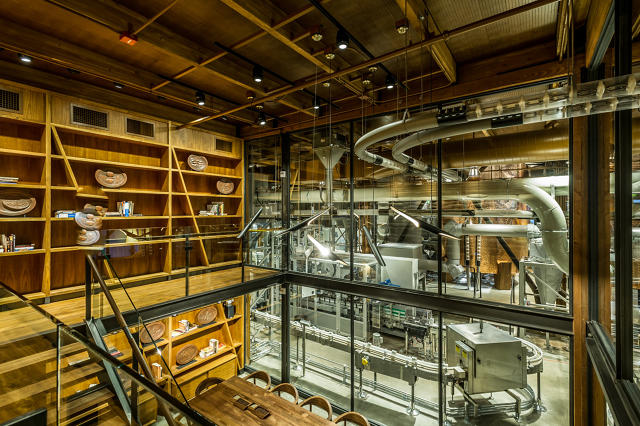
MAKING GOOD WITH OLD BONES
The building itself is was constructed in 1910 as a Packard automobile dealership in gleaming terra cotta. It has changed hands and purposes a few times over the past century—once it was a Volvo dealership, another time it was an art supply store—and fell into predictable disrepair. When Starbucks leased it in 2013, Muller’s first step was to strip down the space to its bones to find what was there. She discovered white terrazzo floors, flecked with copper, and a ceiling of toasty Douglas fir that had been painted black.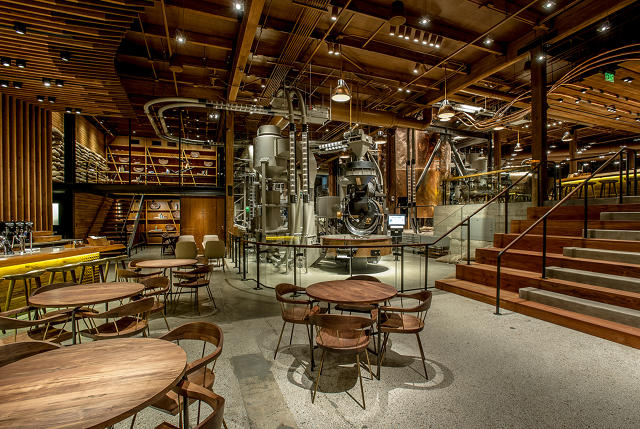
She soon set about restoring many of the historic finishes and imagined the space "in every color of coffee" through wood, leather, and copper. The vertical beams ensconcing the entry way are stained darker at their tips—like a coffee stirrer, she says. The felt drapes are stitched with copper "cherries" to mimic the fruit of an unpicked coffee bean. A steam-molded wooden bannister along the stairs is constructed from flowing wood slats that reference coffee beans being raked and dried in the sun. And an innocuous bit of greenery framing the refuse area is really a small crop of a two-year-old coffee plant.
The main design challenge was to make 15,000 square feet, dedicated largely to industrial roasting equipment, feel welcoming and even enchanting. From the oily grain of the teak wood bar, to the massive steel suspension beams erected for earthquake safety (themselves wrapped in hand- stitched leather and, where not, coated in wax), every surface of the store is designed to be leaned on or touched.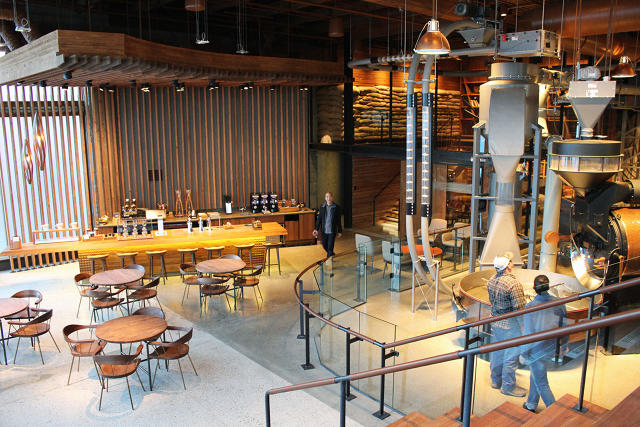
THE THEATER OF MANUFACTURING
But the factory is still the main attraction, and theater was very much on Muller's mind when she designed the space. A line of hulking gray machinery surrounded by a waist-high balustrade—coated in basketball-like leather—sits in the middle of the space, and you can lean in and watch beans roasting. An employee slices open a burlap sack of green coffee beans, dumps them into a floor grate, then lifts them through an elevator of clear piping as the beans make their way to storage vats. From there, more clear pipes send the stored green beans to two different roasters—one smaller for coffee served at the store, one supporting a few hundred pounds of beans at a time for global shipments. Once roasted, the beans are either packed on a line, or snake their way through more transparent tubing to be packed or stored in the copper silo in the middle of the store. "It’s not a show. It’s a true manufacturing plant," Muller says. "We [generally] like showing a little leg under the skirt. But this was like lifting the skirt and saying let’s see it all."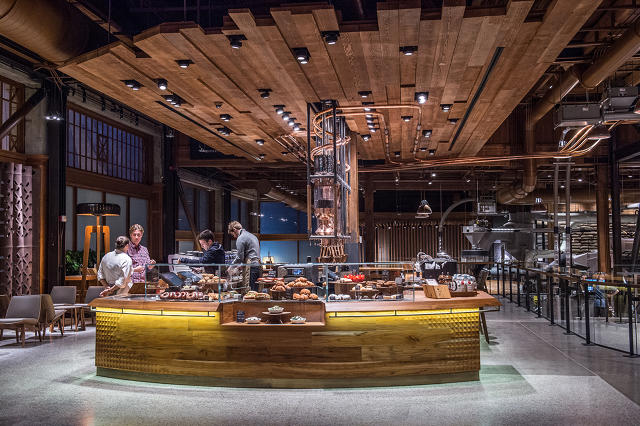
Muller made all sorts of small design moves to milk the show. The lights are kept brighter over the manufacturing area for safety and quality assurance, but they also create a natural stage effect to emphasize the theater. Look closely, and you’ll see that louder machinery has been padded to dull the sound (and acoustic paneling, disguised as wood slats on the ceiling, runs backup to control acoustics). Plus, those Willy Wonka pipes that transport the beans around the floor—what Muller affectionately calls the "jewelry" of the manufacturing equipment—don’t need to be transparent to work. That’s just for the benefit of viewers.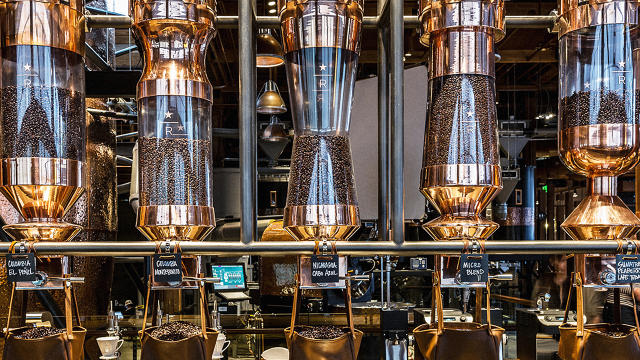
FROM FACTORY TO STORE
An elaborate system marries the factory, where customers gawk at the product, to the store, where customers sample (and buy) the product. The beans that are destined for in-house consumption make their way from the factory line to the main bar by a separate tubing system—beans are sucked pneumatically through a wave of copper pipes into a central coffee bar. Why use copper tubes instead of the transparent style used in the factory? In part, the clear tubing used elsewhere couldn’t be bent with the desired sculptural angles without giving the material an unappetizing blue tint. Muller also liked the aesthetic of copper and the sound that it makes.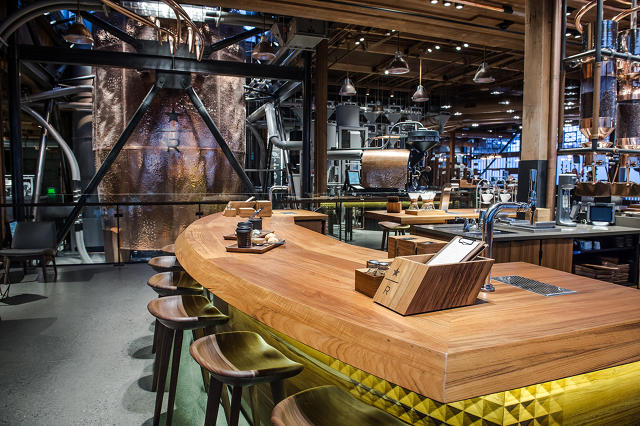
While the store doesn't literally "rain the beans," as Muller says, the sound of beans coursing through those copper pipes from the factory to the coffee bar produce a distinctive rainstick patter. "It’s discovery. To me, it needs to have some intellect," Muller says. "It’s easy to paint a wall. It’s easy to bring some furniture. But it’s not easy to build that [discovery] in."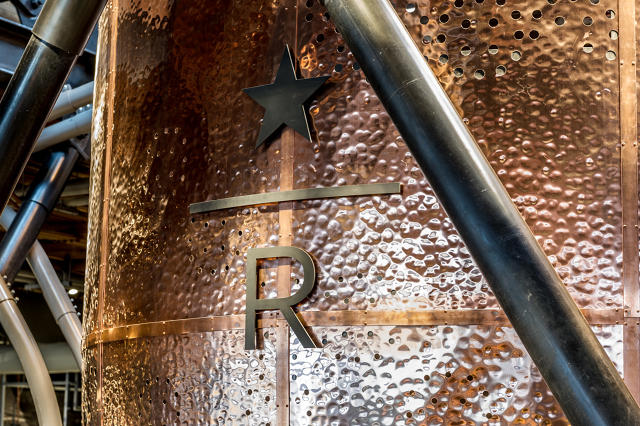
STARBUCKS'S BEST SELF-PORTRAIT YET
As for what this roastery means to the 23,000 other Starbucks locations around the world: The best ideas will be recycled back into the business. The sharper-edged geometric counters, especially, are a departure from the raw wood, sliced tree aesthetic that’s defined Starbucks in the past, and Muller hints that we’ll likely see more of that to come.
This Willy Wonka Starbucks is also indicative of a larger trend across industries. It’s the epitome of the overshare, where businesses reveal their innermost workings as a way of connecting with consumers and strengthening their brand. And it’s a place where Starbucks can both give you a hint of its mechanized scale—where it produces just 0.3% of the 500 million pounds of beans it roasts a year—while publicizing that global mechanism in palpable wood, leather, and copper. The new Starbucks roastery is not just a place for Starbucks to put on a show. It's an embodiment of what Starbucks is: a gargantuan machine that begs to be touched.
Fonte:http://www.fastcodesign.com/3039419/the-worlds-largest-starbucks-is-the-willy-wonka-factory-of-coffee?partner=rss